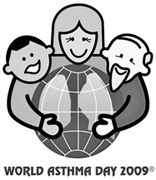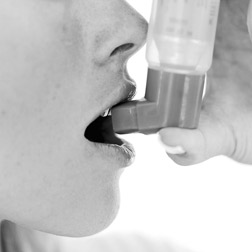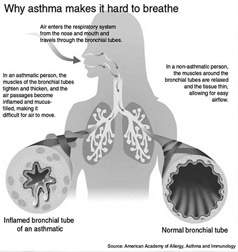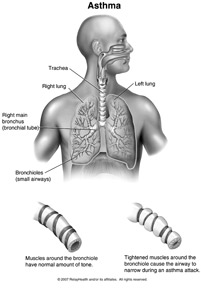|

Proper management could even lead to a drug - free
life:
Do not let asthma run you down
|

Dr. Bandu Gunasena
|
 What do Elizabeth Taylor, Bill Clinton, Mark Spitz and Lindsay Lohan
have in common? Asthma. These people have not only lived with the
disease but have determined not to let it get in the way of their
success. Although it is believed there is no cure hundreds of Sri
Lankans with asthma live healthy, active lives. In some cases once a
patient is in control of the disease by following medical advice
properly and consistently, they are able to manage without any
medication at all. What do Elizabeth Taylor, Bill Clinton, Mark Spitz and Lindsay Lohan
have in common? Asthma. These people have not only lived with the
disease but have determined not to let it get in the way of their
success. Although it is believed there is no cure hundreds of Sri
Lankans with asthma live healthy, active lives. In some cases once a
patient is in control of the disease by following medical advice
properly and consistently, they are able to manage without any
medication at all.
But the nature and extent of the disease is not to be underestimated.
Asthma is a chronic inflammatory disease. It is an allergic reaction
that affects the ‘bronchial tree’, normally a patent structure,
narrowing the airways resulting in difficulty to breath.
Three hundred million people of the world population have been
suffering from asthma. Twenty-five percent of the children and 10% of
the aged population in Sri Lanka have been affected by this disease.
Thousand out of 160,000 patients admitted to hospitals annually die of
this disease in Sri Lanka.
Dr. Bandu Gunasena, Consultant Chest physician, Chest Hospital,
Welisara said that in Sri Lanka as in any of the third world country
Asthma is under treated. “It is a disease that is misdiagnosed by
patients and doctors alike”, said he. The social stigma attached to it
prevents patients from seeking medical attention. “As soon as a patient
is diagnosed with asthma he or she changes doctors, resulting in loss of
valuable time.” Earlier the diagnosis is the better, said he.
Symptoms
 There are two types of asthma - intermittent and persistent. Symptoms
of both are generally the same - wheezing, cough, chest tightness, and
shortness of breath - the difference being that with intermittent asthma
symptoms prevail intermittently for two to three hours. “Most people
mistake wheezing as a disease, in fact it is only a symptom of asthma,
which occurs as a result of laboured breathing, due to narrowed
bronchial tubes”, explained Dr. Gunasena. There are two types of asthma - intermittent and persistent. Symptoms
of both are generally the same - wheezing, cough, chest tightness, and
shortness of breath - the difference being that with intermittent asthma
symptoms prevail intermittently for two to three hours. “Most people
mistake wheezing as a disease, in fact it is only a symptom of asthma,
which occurs as a result of laboured breathing, due to narrowed
bronchial tubes”, explained Dr. Gunasena.
Asthma may initially manifest itself as a difficulty to breathe out
and later inhaling also becomes difficult. The condition often manifest
at an early age and progresses as the patient ages.
In the case of intermittent asthma cough may come and go making it
difficult for doctors to make an accurate diagnosis, since lungs maybe
clear at the time of examination, explained Dr. Gunasena. “But if
patients cough at night and are awaken with a tightness of chest and if
the symptoms correspond with cold weather, a sudden change in humidity
it is clearly indicative of asthma.”
In persistent asthma the symptoms persist for more or less the whole
day. “This can be a serious condition”, said Dr. Gunasena. The severity
of the condition can differ with the person. “Some people can straight
away develop a sever case of asthma”.
Causes
Causes of asthma can be two fold - congenital and hereditary. “A
person whose both parents have asthma have a higher risk of developing
the condition than a person with one parent suffering from asthma”, said
Dr. Gunasena. “But having a tendency does not mean that a person would
definitely develop the condition.”
Interaction with the environment could also trigger asthma,
especially in those who have a congenital tendency to develop the
condition. Contact with cat fur, pollen, chemical material, pollutants,
smoke and dust act as stimulants. “But a certain allergy, triggering
asthma depends on ones physiology.”
Environmental factors such as a sudden change in humidity as said
above as well as activities such as dancing, singing or even laughing
could trigger an attack, while a common cold could precipitate a major
episode, said Dr. Gunasena.
Diagnosis
 In the early stage wheezing could be detected by the physician by a
simple stethoscope examination. If the condition has progressed the
patient may notice wheezing on his or her own. A person’s history or
genetics and a simple stethoscope examination could rule out asthma
while chest X-rays and blood tests could also be conducted. “What is
referred to as the ‘peak flow metre’ that measures the speed of air flow
can be used to make a diagnosis”, said Dr. Gunasena. In the early stage wheezing could be detected by the physician by a
simple stethoscope examination. If the condition has progressed the
patient may notice wheezing on his or her own. A person’s history or
genetics and a simple stethoscope examination could rule out asthma
while chest X-rays and blood tests could also be conducted. “What is
referred to as the ‘peak flow metre’ that measures the speed of air flow
can be used to make a diagnosis”, said Dr. Gunasena.
Treatment
“There are two main principals to managing asthma”, explained Dr.
Gunasena “Relieve suffering and preventing the condition from
recurring.” Both the types of drugs come in colour coded dry powder
capsules or pressurized canisters for easy identification. Reliever
medication comes in a universal blue where as preventer medication comes
in several colours - brown, orange and burgundy.
Physicians prescribe bronchodilator drugs to expand the bronchial
tubes. However it’s effect is temporary. These ‘reliever medications’
can also have adverse effects if used regularly. Since lungs tend to
rely on the drugs, patients develop an addiction to reliever drugs.
‘Preventer drugs’ are safer although they do not provide instant
relief, explained Dr. Gunasena. “As you continue to use this type of
drugs the severity as well as the frequency of episodes gradually
decreases and may even cease all together! If a patient is in good
control of the situation he may be able to lead a normal, healthy life
without any medication.”
But as Dr. Gunasena pointed out, a major mistake made by patients is
discontinuing medication as soon as they stop having asthma attacks,
resulting in a relapse that could render years of effort in vain. “A
patient should never stop medication without doctor’s orders”, warned
Dr. Gunasena.

 All asthma drugs contain steroids, but inhaler drugs contain minute
doses. If a patient does not take medication properly it could result in
a sever asthma attack that could land him or her in the hospital,
explained Dr. Gunasena. “This would mean taking in a lot more steroids.” All asthma drugs contain steroids, but inhaler drugs contain minute
doses. If a patient does not take medication properly it could result in
a sever asthma attack that could land him or her in the hospital,
explained Dr. Gunasena. “This would mean taking in a lot more steroids.”
Prevention
“Although it is thought that dust, cat fur and other environmental
pollutants trigger asthma, no matter how clean you maybe, getting asthma
depends on your physiology.”
Ideal sport for asthmatic patients is swimming, because it involves
breathing in high humidity.
Occupational asthma can occur when a person is exposed to large
amounts of dust, fume and certain chemicals at workplace. “If a person
exhibits asthmatic symptoms within the first few days of a job
appointment, it could be indicative of occupational asthma,” in which
case Dr. Gunasena advised that a patient should be subjected to a
thorough evaluation and if necessary change their occupation.
As Dr. Gunasena explained, unlike other chronic diseases such as high
blood pressure and diabetes, if a patient is in control of the condition
he or she may not require drugs for long periods.
“There are cases that, with time, patients do not need any drugs at
all.” With any other chronic disease patients have to change their
lifestyle but asthma patients can lead a normal, healthy life and have a
life expectancy as that of a normal person if they are able to properly
manage the condition. SP
Health News
Excess weight gain during pregnancy unhealthy for mom and baby
by Susan Brady
 Women who put on too much weight during pregnancy risk not only
keeping that weight after birth, but also have higher rates of
complications, such as developing high blood pressure and gestational
diabetes or requiring a Cesarean section. Those starting out obese are
also at an increased risk for pre-eclampsia and blood clots, not to
mention complications from a C-section. Women who put on too much weight during pregnancy risk not only
keeping that weight after birth, but also have higher rates of
complications, such as developing high blood pressure and gestational
diabetes or requiring a Cesarean section. Those starting out obese are
also at an increased risk for pre-eclampsia and blood clots, not to
mention complications from a C-section.
A new study, appearing in the American Journal of Clinical Nutrition,
showed that women who gained excess pounds during gestation went on to
gain an average of 44 pounds over the next 20+ years. However, those who
gained relatively little weight gained an average of 20 pounds during
the same time period.
According to the guidelines from the Institute of Medicine (IOM), the
heavier a woman is, the less weight she should gain during pregnancy.
Underweight women, body mass index (BMI) of 18.5, should pack on 28
to 49 pounds if carrying a singleton; healthy women of normal BMI should
gain 25 to 35 pounds; overweight women, BMI of 25 to 29.9, should gain
15 to 25 pounds; obese women, BMI of 30 of higher, should gain only 11
to 20 pounds. For women giving birth to twins: normal-weight women
should gain 37 to 54 pounds; overweight women should gain 31 to 50
pounds; and obese women should gain 25 to 42 pounds. These revised
guidelines use BMI ranges set by the World Health Organization and the
National Heart, Lung and Blood Institute.
Dr. Abdullah A. Mamun, of the University of Queensland, and his
colleagues used the IOM guidelines in their research. Women who gained
too much weight during their pregnancy, based on the guidelines, were
twice as likely to be overweight later on, and had a more than four-fold
increased risk of being obese.
Approximately half of the pregnant women in the United States today
are either overweight or obese, which is up from about 25 percent four
decades ago. If you start out your pregnancy being overweight or obese,
there is a likelihood that you will keep the weight on after giving
birth. Kaiser Permanente reported on a study last year that showed 3 out
of 4 women who began their nine-month journey obese and gained more than
15 pounds during pregnancy retained 40 percent of the extra weight a
full year after they gave birth.
In addition, there is an increased risk of neural tube defects (NTDs),
particularly spina bifida, strongly linked with maternal obesity. A 2007
study published in the Archives of Paediatric and Adolescent Medicine
showed that, compared with babies born to normal-weight women, babies
born to obese women were twice as likely to have the neural tube defect,
even though the obese mothers were just as likely to take folic acid
supplements prior to conceiving. At that time, the study researchers
surmised that the increased risk could be due to undiagnosed diabetes.
The study also identified other obesity-related risk increases in the
range of 20 to 50 percent for heart defects, limb abnormalities,
malformations in the anal opening or urethra in boys, and a condition
known as diaphragmatic hernia, which can interfere with lung
development.
For optimal outcomes for both mother and baby, it is best to be in
good physical health prior to pregnancy, and to monitor weight gain,
food intake, exercise, and dietary supplements. Your obstetrician or
midwife should be able to provide you with the necessary guidelines for
a healthy pregnancy.
-Healthnews
New test to spot cancer risk
A screening test that takes five minutes and cuts the risk of
developing bowel cancer by a third could save at least 3,000 lives a
year, research has shown.
A study of more than 170,000 volunteers aged between 55 and 64
suggested that the examination of the lower colon and rectum reduced
deaths by 43 per cent. The test, which involves the quick removal of
growths with the potential to turn cancerous, is seen as a strategy that
could transform prevention and early detection of the disease. In the
study group examined, incidence of bowel cancer fell by a third.
Scientists said yesterday that the research, published on The Lancet
website, made the national introduction of the one-off test for all men
and women at the age of 55 a “no brainer”.
A quarter of the volunteers in the 16-year study underwent a
sigmoidoscopy, where a camera mounted on a thin, flexible tube known as
a Flexi-Scope was inserted about a third of the way into the bowel. Most
bowel cancers stem from polyps or symptomless growths in the rectum and
colon and where these were found they were removed in a safe and
pain-free procedure, the researchers said.
Researchers also said that the test could save thousands of lives
every year. Bowel cancer is the third most common cancer in Britain and
the second biggest cancer killer.
The present screening method, called the faecal occult blood test,
shows any traces of blood in stools and helps to detect the cancer at an
early stage. This test, which has been extended to people over 60, would
continue as it can identify cancers farther up the bowel.
Harpal Kumar, chief executive of Cancer Research UK, described the
study, which started in 1994 and is the largest and longest running of
its kind, as “one of those rare occasions to use the word ‘breakthrough’
“.
He called for the next government to add the test to the bowel cancer
screening programme urgently. “It is extremely rare to see the results
of a clinical trial which are quite as compelling as this one and which
has quite the huge impact in terms of the potential for improving cancer
outcomes.” He added: “We have a tremendous opportunity now to use this
procedure to push bowel cancer cases back down the league of cancer
cases in the UK.” The scientists said that rates of bowel cancer
diagnosis - about 100 people a day - would drop quickly with a national
programme.
Professor Wendy Atkin, from Imperial College London, who led the
research, said: “Our study shows for the first time that we could
dramatically reduce the incidence of bowel cancer, and the number of
people dying from the disease, by using this one-off test. No other
bowel cancer screening technique has ever been shown to prevent the
disease.” The study was funded by the Medical Research Council, the
National Institute for Health Research and Cancer Research UK.
-Timesonline
|

